engine CITROEN DS3 2018 Handbook (in English)
[x] Cancel search | Manufacturer: CITROEN, Model Year: 2018, Model line: DS3, Model: CITROEN DS3 2018Pages: 248, PDF Size: 8.79 MB
Page 32 of 248
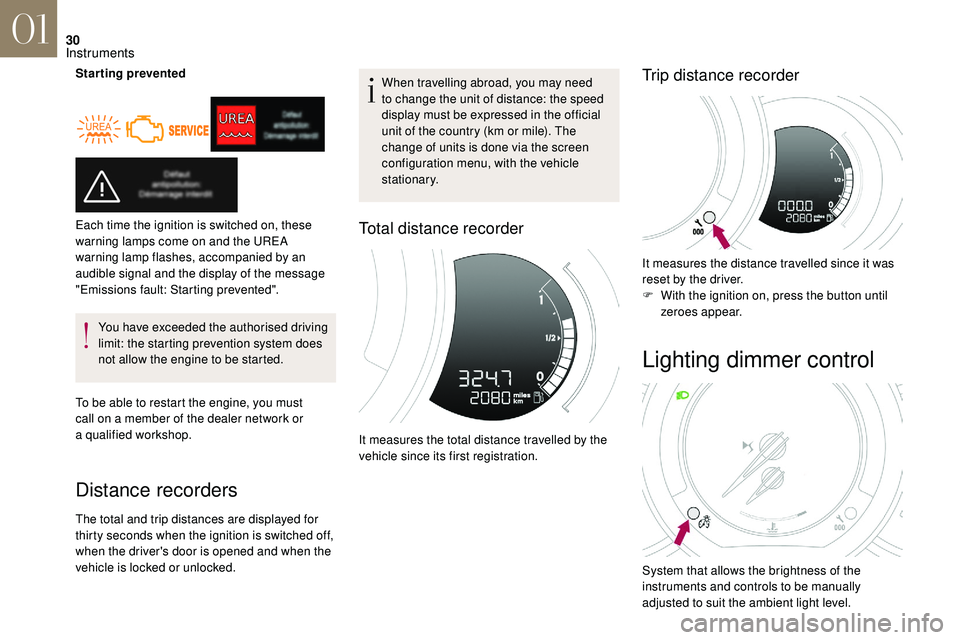
30
Starting preventedYou have exceeded the authorised driving
limit: the starting prevention system does
not allow the engine to be started.
To be able to restart the engine, you must
call on a
member of the dealer network or
a
qualified workshop.
Distance recorders
The total and trip distances are displayed for
thirty seconds when the ignition is switched off,
when the driver's door is opened and when the
vehicle is locked or unlocked. When travelling abroad, you may need
to change the unit of distance: the speed
display must be expressed in the official
unit of the country (km or mile). The
change of units is done via the screen
configuration menu, with the vehicle
stationary.
Total distance recorder
It measures the total distance travelled by the
vehicle since its first registration.
Trip distance recorder
It measures the distance travelled since it was
reset by the driver.
F
W
ith the ignition on, press the button until
zeroes appear.
Each time the ignition is switched on, these
warning lamps come on and the UREA
warning lamp flashes, accompanied by an
audible signal and the display of the message
"Emissions fault: Starting prevented".
Lighting dimmer control
System that allows the brightness of the
instruments and controls to be manually
adjusted to suit the ambient light level.
01
Instruments
Page 47 of 248
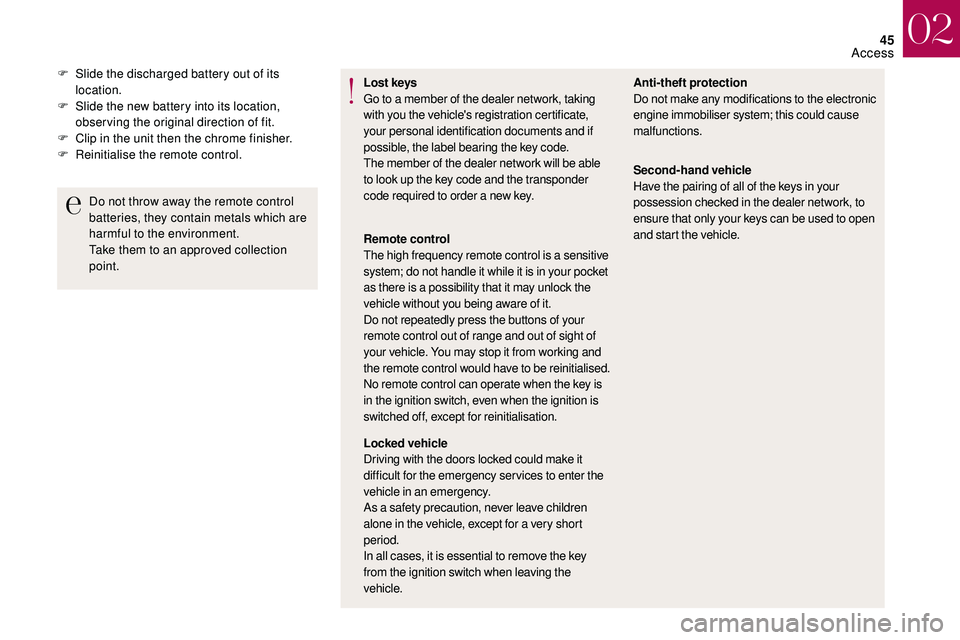
45
Lost keys
Go to a member of the dealer network, taking
with you the vehicle's registration certificate,
your personal identification documents and if
possible, the label bearing the key code.
The member of the dealer network will be able
to look up the key code and the transponder
code required to order a
new key.
Do not throw away the remote control
batteries, they contain metals which are
harmful to the environment.
Take them to an approved collection
point. Anti-theft protection
Do not make any modifications to the electronic
engine immobiliser system; this could cause
malfunctions.
Remote control
The high frequency remote control is a
sensitive
system; do not handle it while it is in your pocket
as there is a
possibility that it may unlock the
vehicle without you being aware of it.
Do not repeatedly press the buttons of your
remote control out of range and out of sight of
your vehicle. You may stop it from working and
the remote control would have to be reinitialised.
No remote control can operate when the key is
in the ignition switch, even when the ignition is
switched off, except for reinitialisation.
Locked vehicle
Driving with the doors locked could make it
difficult for the emergency services to enter the
vehicle in an emergency.
As a
safety precaution, never leave children
alone in the vehicle, except for a
very short
period.
In all cases, it is essential to remove the key
from the ignition switch when leaving the
vehicle. Second-hand vehicle
Have the pairing of all of the keys in your
possession checked in the dealer network, to
ensure that only your keys can be used to open
and start the vehicle.
F
S
lide the discharged battery out of its
location.
F
S
lide the new battery into its location,
observing the original direction of fit.
F
C
lip in the unit then the chrome finisher.
F
R
einitialise the remote control.
02
Access
Page 51 of 248
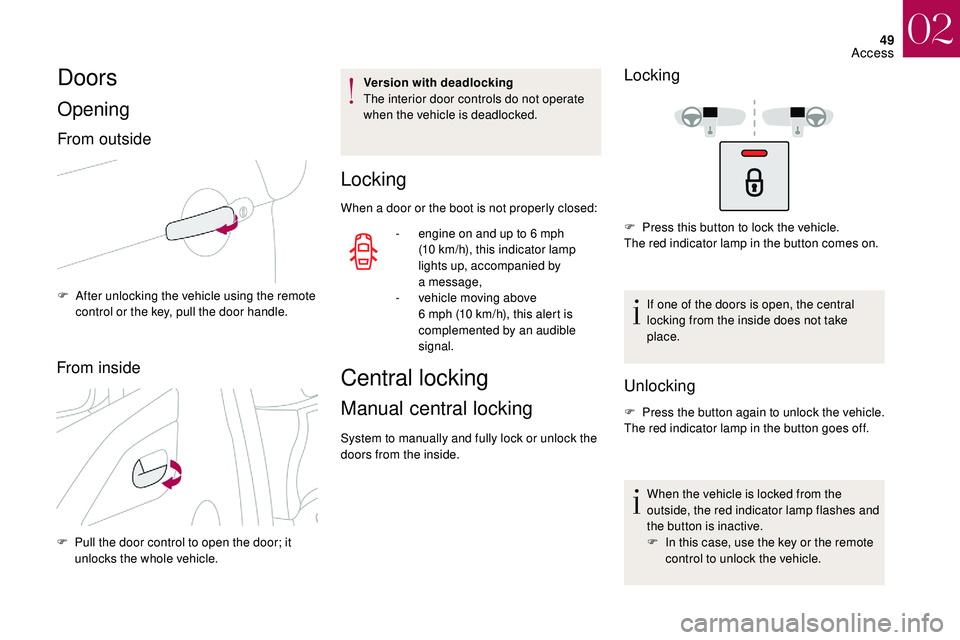
49
Doors
Opening
From outside
F After unlocking the vehicle using the remote control or the key, pull the door handle.
From inside
F Pull the door control to open the door; it unlocks the whole vehicle. Version with deadlocking
The interior door controls do not operate
when the vehicle is deadlocked.
Locking
- engine on and up to 6
mph
(10 km/h), this indicator lamp
lights up, accompanied by
a
message,
-
v
ehicle moving above
6
mph (10 km/h), this alert is
complemented by an audible
signal.
When a
door or the boot is not properly closed:
Central locking
Manual central locking
System to manually and fully lock or unlock the
doors from the inside.
Locking
If one of the doors is open, the central
locking from the inside does not take
place.
Unlocking
F Press the button again to unlock the vehicle.
The red indicator lamp in the button goes off.
When the vehicle is locked from the
outside, the red indicator lamp flashes and
the button is inactive.
F
I
n this case, use the key or the remote
control to unlock the vehicle.
F
P
ress this button to lock the vehicle.
The red indicator lamp in the button comes on.
02
Access
Page 53 of 248
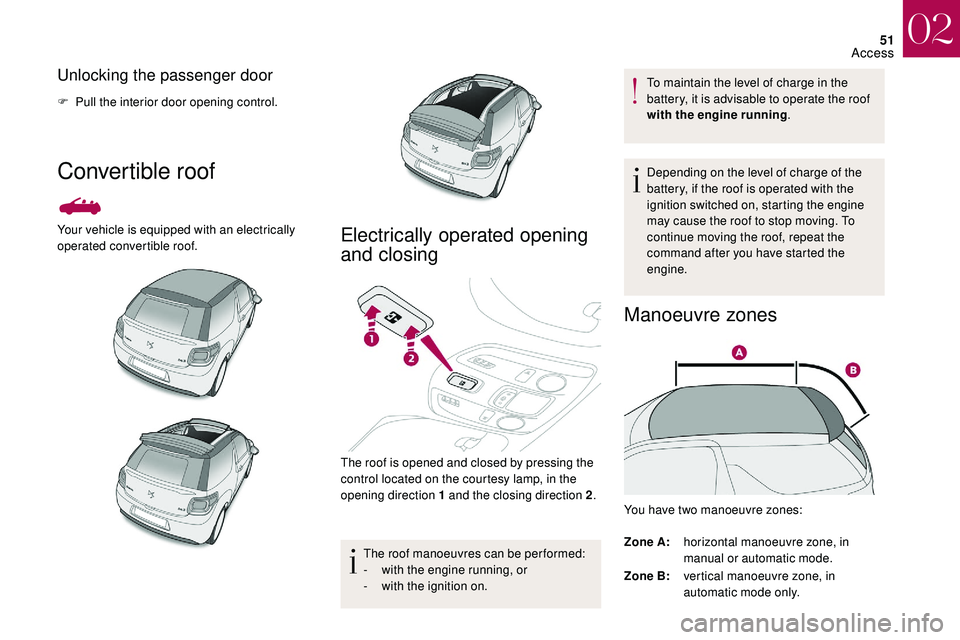
51
Unlocking the passenger door
F Pull the interior door opening control.
Convertible roof
Your vehicle is equipped with an electrically
operated convertible roof.Electrically operated opening
and closing
The roof is opened and closed by pressing the
control located on the courtesy lamp, in the
opening direction 1 and the closing direction 2 .
The roof manoeuvres can be per formed:
-
w
ith the engine running, or
-
w
ith the ignition on. To maintain the level of charge in the
battery, it is advisable to operate the roof
with the engine running
.
Depending on the level of charge of the
battery, if the roof is operated with the
ignition switched on, starting the engine
may cause the roof to stop moving. To
continue moving the roof, repeat the
command after you have started the
engine.
Manoeuvre zones
You have two manoeuvre zones:
Zone A: horizontal manoeuvre zone, in
manual or automatic mode.
Zone B: vertical manoeuvre zone, in
automatic mode only.
02
Access
Page 56 of 248
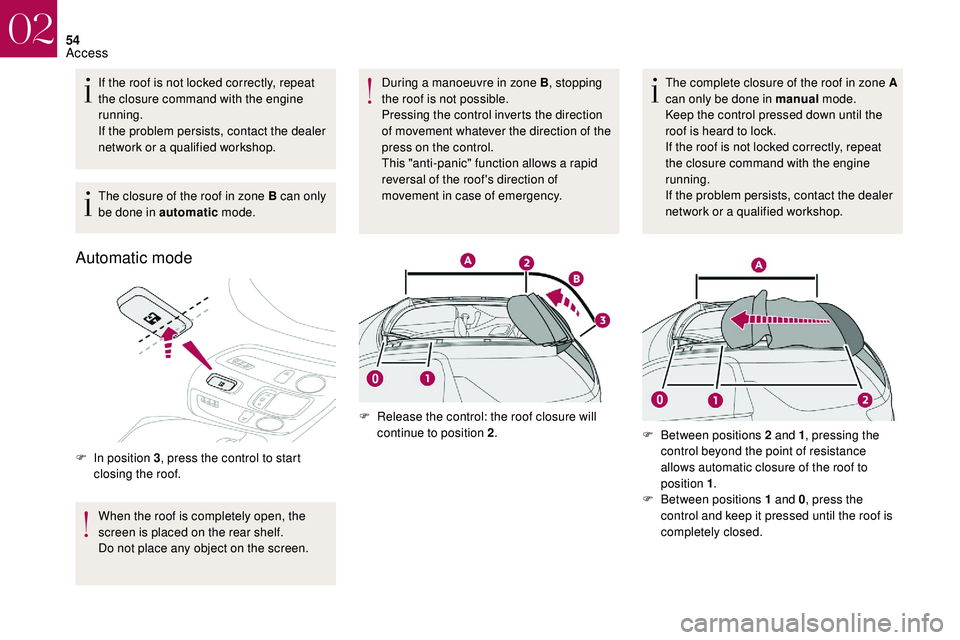
54
If the roof is not locked correctly, repeat
the closure command with the engine
running.
If the problem persists, contact the dealer
network or a qualified workshop.
The closure of the roof in zone B can only
be done in automatic mode.
Automatic mode
F In position 3, press the control to start
closing the roof.
When the roof is completely open, the
screen is placed on the rear shelf.
Do not place any object on the screen. During a
manoeuvre in zone B
, stopping
the roof is not possible.
Pressing the control inverts the direction
of movement whatever the direction of the
press on the control.
This "anti-panic" function allows a
rapid
reversal of the roof 's direction of
movement in case of emergency.
F
R
elease the control: the roof closure will
continue to position 2 . The complete closure of the roof in zone A
can only be done in manual
mode.
Keep the control pressed down until the
roof is heard to lock.
If the roof is not locked correctly, repeat
the closure command with the engine
running.
If the problem persists, contact the dealer
network or a qualified workshop.
F
Be
tween positions 2 and 1
, pressing the
control beyond the point of resistance
allows automatic closure of the roof to
position 1 .
F
Be
tween positions 1 and 0, press the
control and keep it pressed until the roof is
completely closed.
02
Access
Page 58 of 248
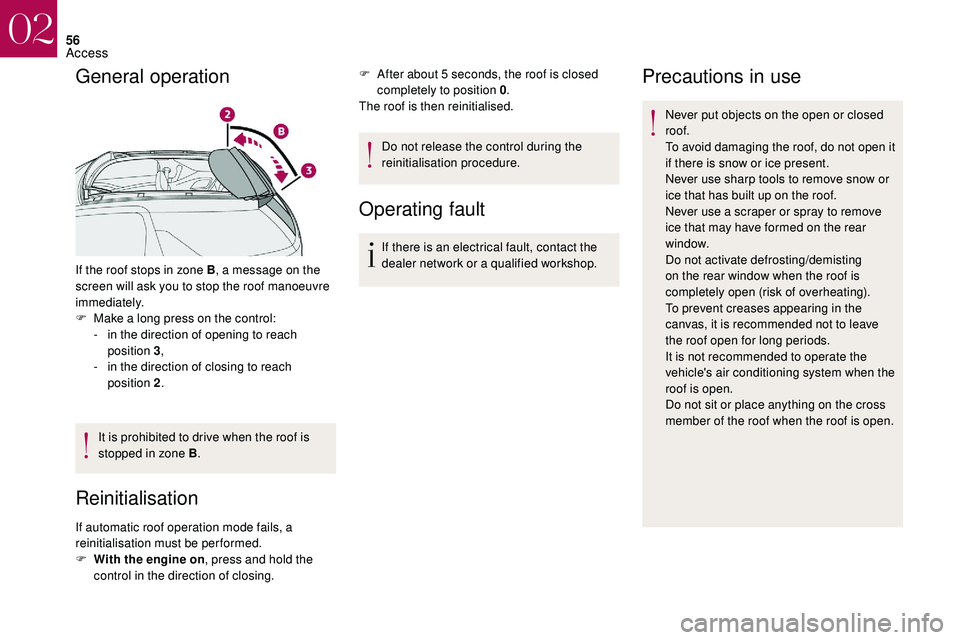
56
General operation
If the roof stops in zone B, a message on the
screen will ask you to stop the roof manoeuvre
immediately.
F
M
ake a long press on the control:
-
i
n the direction of opening to reach
position 3 ,
-
i
n the direction of closing to reach
position 2 .
It is prohibited to drive when the roof is
stopped in zone B .
Reinitialisation
If automatic roof operation mode fails, a
reinitialisation must be performed.
F
W
ith the engine on, press and hold the
control in the direction of closing. F
A
fter about 5 seconds, the roof is closed
completely to position 0 .
The roof is then reinitialised.
Do not release the control during the
reinitialisation procedure.
Operating fault
If there is an electrical fault, contact the
dealer network or a qualified workshop.
Precautions in use
Never put objects on the open or closed
roof.
To avoid damaging the roof, do not open it
if there is snow or ice present.
Never use sharp tools to remove snow or
ice that has built up on the roof.
Never use a
scraper or spray to remove
ice that may have formed on the rear
window.
Do not activate defrosting/demisting
on the rear window when the roof is
completely open (risk of overheating).
To prevent creases appearing in the
canvas, it is recommended not to leave
the roof open for long periods.
It is not recommended to operate the
vehicle's air conditioning system when the
roof is open.
Do not sit or place anything on the cross
member of the roof when the roof is open.
02
Access
Page 59 of 248

57
If the vehicle is to be parked outside for
a long period, it is advisable to protect the
roof using a
tarpaulin.
It is advisable to close the roof when you
park the vehicle.
Even if the roof is closed, it is safer not to
leave any valuables inside the vehicle.
Remove the ignition key when you leave
the vehicle to prevent any involuntary roof
movement.
If your vehicle has a
voice command
system, it may be affected if you drive with
the roof open.
Protection of electric motors that control
roof opening and closure: during repeated
opening and closing movements of the
roof, it is possible that heating up of the
electric motors no longer allows the roof to
be opened or closed. Allow the motors to
cool by not trying to move the roof for ten
minutes.Boot
Opening
Closing
- when the engine is running ,
this warning lamp comes on,
accompanied by a
message in
the multifunction screen for a
few
seconds,
-
w
hen the vehicle is moving
(speed higher than 6
mph
(10
km/h)), this warning lamp
comes on, accompanied by an
audible signal and a
message in
the multifunction screen for a
few
seconds.
Back-up control
Unlocking
F Fold back the rear seats to gain access to the lock from inside the boot.
F
I
nsert a small screwdriver into hole A of the
lock to unlock the boot.
F
A
fter unlocking the vehicle, press the
opening control and then open the boot.
F
L
ower the tailgate using the interior grab
handle.
If the tailgate is not fully closed: Measures for mechanically unlocking the boot
in the event of a battery or central locking fault.
02
Access
Page 60 of 248
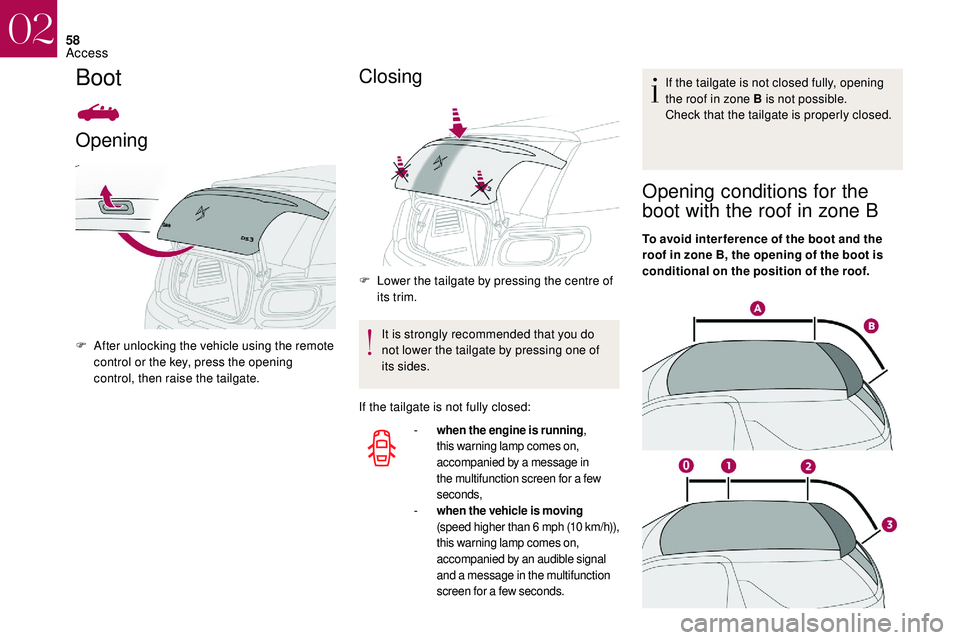
58
Boot
Opening
F After unlocking the vehicle using the remote control or the key, press the opening
control, then raise the tailgate.
Closing
F Lower the tailgate by pressing the centre of its trim.
It is strongly recommended that you do
not lower the tailgate by pressing one of
its sides.
If the tailgate is not fully closed: -
when the engine is running ,
this warning lamp comes on,
accompanied by a
message in
the multifunction screen for a
few
seconds,
- when the vehicle is moving
(speed higher than 6 mph (10 km/h)),
this warning lamp comes on,
accompanied by an audible signal
and a
message in the multifunction
screen for a
few seconds.
If the tailgate is not closed fully, opening
the roof in zone B is not possible.
Check that the tailgate is properly closed.
Opening conditions for the
boot with the roof in zone B
To avoid inter ference of the boot and the
roof in zone B, the opening of the boot is
conditional on the position of the roof.
02
Access
Page 64 of 248
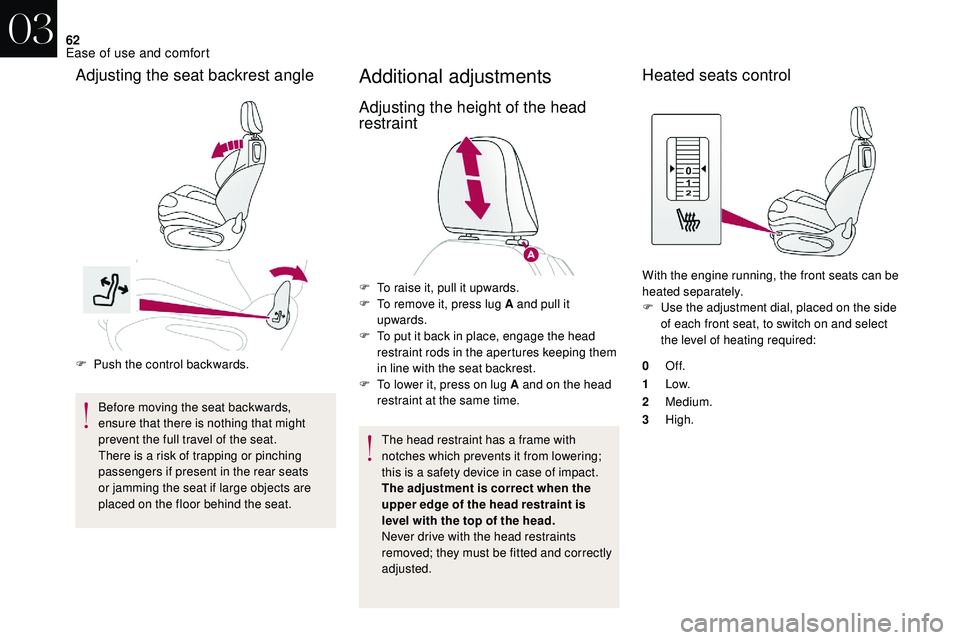
62
F Push the control backwards.Before moving the seat backwards,
ensure that there is nothing that might
prevent the full travel of the seat.
There is a
risk of trapping or pinching
passengers if present in the rear seats
or jamming the seat if large objects are
placed on the floor behind the seat.
Additional adjustments
Adjusting the height of the head
restraint
The head restraint has a frame with
n otches which prevents it from lowering;
this is a
safety device in case of impact.
The adjustment is correct when the
upper edge of the head restraint is
level with the top of the head.
Never drive with the head restraints
removed; they must be fitted and correctly
adjusted.
Heated seats control
With the engine running, the front seats can be
heated separately.
F
U
se the adjustment dial, placed on the side
of each front seat, to switch on and select
the level of heating required:
0 Of f.
1 Low.
2 Medium.
3 High.
Adjusting the seat backrest angle
F To raise it, pull it upwards.
F
T o remove it, press lug A and pull it
upwards.
F
T
o put it back in place, engage the head
restraint rods in the apertures keeping them
in line with the seat backrest.
F
T
o lower it, press on lug A and on the head
restraint at the same time.
03
Ease of use and comfort
Page 72 of 248
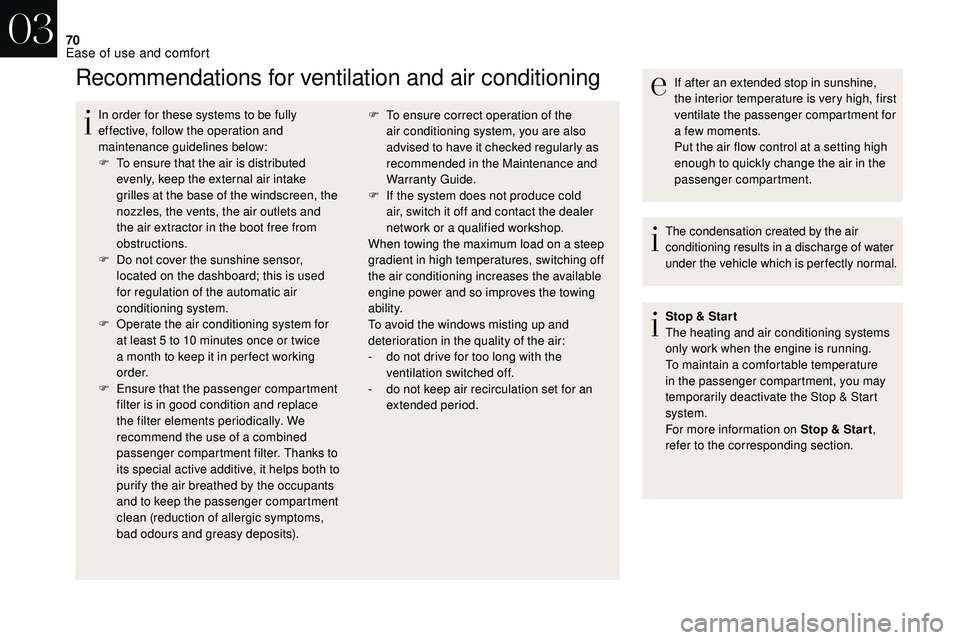
70
Recommendations for ventilation and air conditioning
In order for these systems to be fully
effective, follow the operation and
maintenance guidelines below:
F
T
o ensure that the air is distributed
evenly, keep the external air intake
grilles at the base of the windscreen, the
nozzles, the vents, the air outlets and
the air extractor in the boot free from
obstructions.
F
D
o not cover the sunshine sensor,
located on the dashboard; this is used
for regulation of the automatic air
conditioning system.
F
O
perate the air conditioning system for
at least 5
to 10 minutes once or twice
a
month to keep it in per fect working
o r d e r.
F
E
nsure that the passenger compartment
filter is in good condition and replace
the filter elements periodically. We
recommend the use of a
combined
passenger compartment filter. Thanks to
its special active additive, it helps both to
purify the air breathed by the occupants
and to keep the passenger compartment
clean (reduction of allergic symptoms,
bad odours and greasy deposits). If after an extended stop in sunshine,
the interior temperature is very high, first
ventilate the passenger compartment for
a
few moments.
Put the air flow control at a
setting high
enough to quickly change the air in the
passenger compartment.
The condensation created by the air
conditioning results in a
discharge of water
under the vehicle which is per fectly normal.
Stop & Star t
The heating and air conditioning systems
only work when the engine is running.
To maintain a
comfortable temperature
in the passenger compartment, you may
temporarily deactivate the Stop & Start
system.
For more information on Stop & Star t ,
refer to the corresponding section.
F
T o ensure correct operation of the
air conditioning system, you are also
advised to have it checked regularly as
recommended in the Maintenance and
Warranty Guide.
F
I
f the system does not produce cold
air, switch it off and contact the dealer
network or a
qualified workshop.
When towing the maximum load on a
steep
gradient in high temperatures, switching off
the air conditioning increases the available
engine power and so improves the towing
ability.
To avoid the windows misting up and
deterioration in the quality of the air:
-
d
o not drive for too long with the
ventilation switched off.
-
d
o not keep air recirculation set for an
extended period.
03
Ease of use and comfort